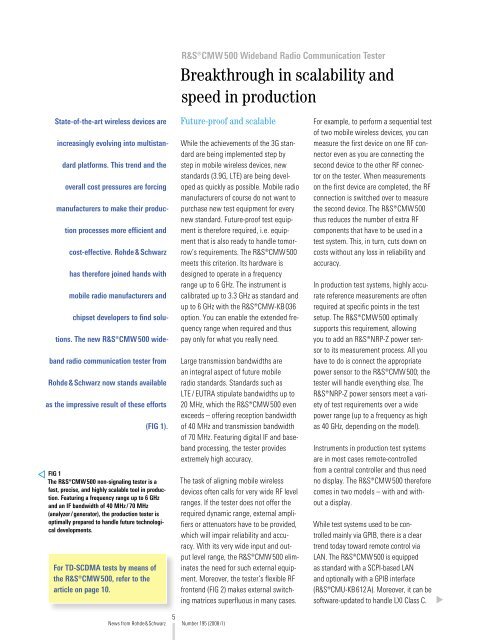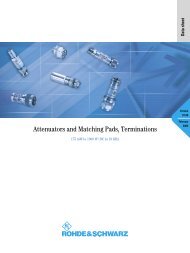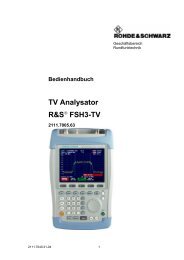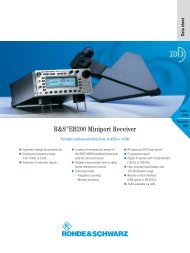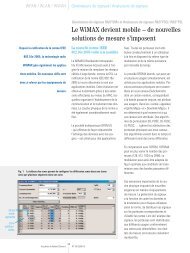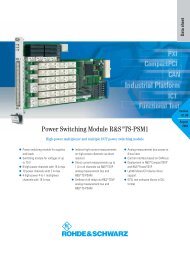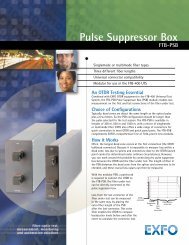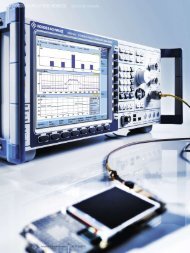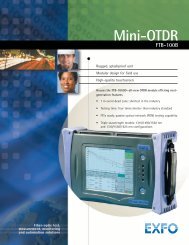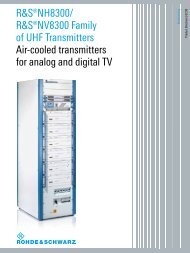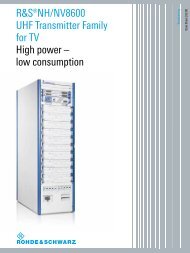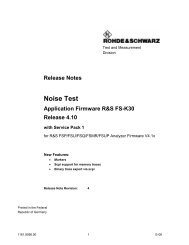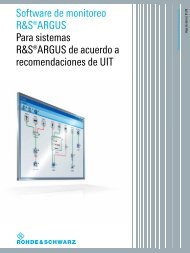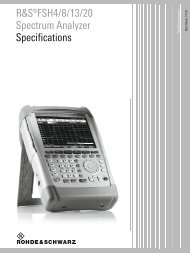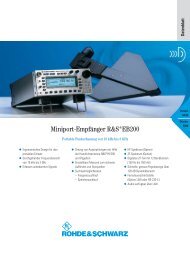Download article as PDF (0.8 MB) - Rohde & Schwarz
Download article as PDF (0.8 MB) - Rohde & Schwarz
Download article as PDF (0.8 MB) - Rohde & Schwarz
You also want an ePaper? Increase the reach of your titles
YUMPU automatically turns print PDFs into web optimized ePapers that Google loves.
R&S ® CMW500 Wideband Radio Communication Tester<br />
Breakthrough in scalability and<br />
speed in production<br />
State-of-the-art wireless devices are<br />
incre<strong>as</strong>ingly evolving into multistandard<br />
platforms. This trend and the<br />
overall cost pressures are forcing<br />
manufacturers to make their production<br />
processes more efficient and<br />
cost- effective. <strong>Rohde</strong> & <strong>Schwarz</strong><br />
h<strong>as</strong> therefore joined hands with<br />
mobile radio manufacturers and<br />
chipset developers to find solutions.<br />
The new R&S ® CMW500 wideband<br />
radio communication tester from<br />
<strong>Rohde</strong> & <strong>Schwarz</strong> now stands available<br />
<strong>as</strong> the impressive result of these efforts<br />
(FIG 1).<br />
FIG 1<br />
The R&S ® CMW500 non-signaling tester is a<br />
f<strong>as</strong>t, precise, and highly scalable tool in production.<br />
Featuring a frequency range up to 6 GHz<br />
and an IF bandwidth of 40 MHz / 70 MHz<br />
(analyzer / generator), the production tester is<br />
optimally prepared to handle future technological<br />
developments.<br />
For TD-SCDMA tests by means of<br />
the R&S ® CMW500, refer to the<br />
<strong>article</strong> on page 10.<br />
News from <strong>Rohde</strong>&<strong>Schwarz</strong><br />
Future-proof and scalable<br />
While the achievements of the 3G standard<br />
are being implemented step by<br />
step in mobile wireless devices, new<br />
standards (3.9G, LTE) are being developed<br />
<strong>as</strong> quickly <strong>as</strong> possible. Mobile radio<br />
manufacturers of course do not want to<br />
purch<strong>as</strong>e new test equipment for every<br />
new standard. Future-proof test equipment<br />
is therefore required, i. e. equipment<br />
that is also ready to handle tomorrow’s<br />
requirements. The R&S ® CMW500<br />
meets this criterion. Its hardware is<br />
designed to operate in a frequency<br />
range up to 6 GHz. The instrument is<br />
calibrated up to 3.3 GHz <strong>as</strong> standard and<br />
up to 6 GHz with the R&S ® CMW-KB036<br />
option. You can enable the extended frequency<br />
range when required and thus<br />
pay only for what you really need.<br />
Large transmission bandwidths are<br />
an integral <strong>as</strong>pect of future mobile<br />
radio standards. Standards such <strong>as</strong><br />
LTE / EUTRA stipulate bandwidths up to<br />
20 MHz, which the R&S ® CMW500 even<br />
exceeds – offering reception bandwidth<br />
of 40 MHz and transmission bandwidth<br />
of 70 MHz. Featuring digital IF and b<strong>as</strong>eband<br />
processing, the tester provides<br />
extremely high accuracy.<br />
The t<strong>as</strong>k of aligning mobile wireless<br />
devices often calls for very wide RF level<br />
ranges. If the tester does not offer the<br />
required dynamic range, external amplifiers<br />
or attenuators have to be provided,<br />
which will impair reliability and accuracy.<br />
With its very wide input and output<br />
level range, the R&S ® CMW500 eliminates<br />
the need for such external equipment.<br />
Moreover, the tester’s flexible RF<br />
frontend (FIG 2) makes external switching<br />
matrices superfluous in many c<strong>as</strong>es.<br />
5<br />
Number 195 (2008/I)<br />
For example, to perform a sequential test<br />
of two mobile wireless devices, you can<br />
me<strong>as</strong>ure the first device on one RF connector<br />
even <strong>as</strong> you are connecting the<br />
second device to the other RF connector<br />
on the tester. When me<strong>as</strong>urements<br />
on the first device are completed, the RF<br />
connection is switched over to me<strong>as</strong>ure<br />
the second device. The R&S ® CMW500<br />
thus reduces the number of extra RF<br />
components that have to be used in a<br />
test system. This, in turn, cuts down on<br />
costs without any loss in reliability and<br />
accuracy.<br />
In production test systems, highly accurate<br />
reference me<strong>as</strong>urements are often<br />
required at specific points in the test<br />
setup. The R&S ® CMW500 optimally<br />
supports this requirement, allowing<br />
you to add an R&S ® NRP-Z power sensor<br />
to its me<strong>as</strong>urement process. All you<br />
have to do is connect the appropriate<br />
power sensor to the R&S ® CMW500; the<br />
test er will handle everything else. The<br />
R&S ® NRP-Z power sensors meet a variety<br />
of test requirements over a wide<br />
power range (up to a frequency <strong>as</strong> high<br />
<strong>as</strong> 40 GHz, depending on the model).<br />
Instruments in production test systems<br />
are in most c<strong>as</strong>es remote-controlled<br />
from a central controller and thus need<br />
no display. The R&S ® CMW500 therefore<br />
comes in two models – with and without<br />
a display.<br />
While test systems used to be controlled<br />
mainly via GPIB, there is a clear<br />
trend today toward remote control via<br />
LAN. The R&S ® CMW500 is equipped<br />
<strong>as</strong> standard with a SCPI-b<strong>as</strong>ed LAN<br />
and optionally with a GPIB interface<br />
(R&S ® CMU-KB612A). Moreover, it can be<br />
software-updated to handle LXI Cl<strong>as</strong>s C.


